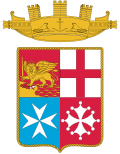| History | |
|---|---|
| Name | USSP |
| Namesake | Unità Supporto Subacqueo Polivalente - Multipurpose submarine rescue vessel |
| Builder | Fincantieri |
| Cost | planned for € (EUR) 434 million [1] |
| Status | Financed with 2017's balance law |
| General characteristics | |
| Type | Submarine rescue ship |
| Displacement | 10.500 t (10.334 long tons) full load [2] |
| Length | |
| Beam | 23 m (75 ft 6 in) |
| Depth | 9 m (29 ft 6 in) |
| Propulsion |
|
| Speed | 18 knots (33 km/h; 21 mph) |
| Range | 6,000 nmi (11,000 km; 6,900 mi) to 12 knots (22 km/h; 14 mph) |
| Endurance | 30 days |
| Complement |
|
| Sensors & processing systems |
|
| Electronic warfare & decoys | EW system |
| Armament |
|
| Notes |
|
USSP is a planned Submarine rescue ship of the Marina Militare, financed with 2017's balance law. [3] It is expected to replace Italian ship Anteo (A 5309).[ citation needed ]
